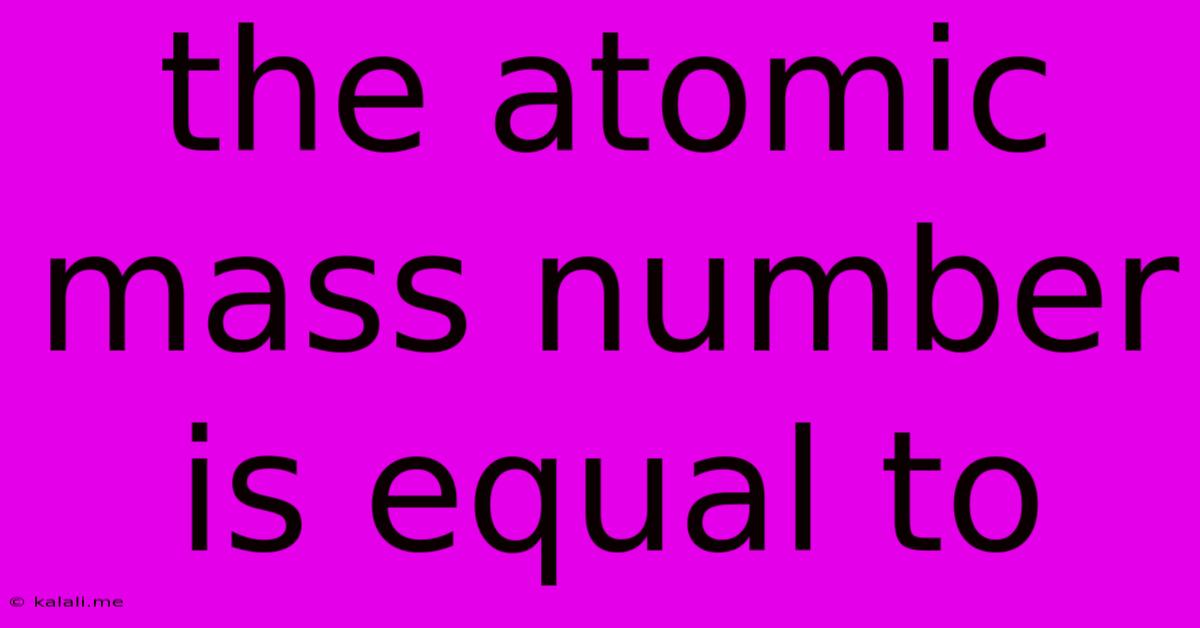The Atomic Mass Number Is Equal To
Kalali
Jun 15, 2025 · 3 min read

Table of Contents
The Atomic Mass Number: What It Is and How to Calculate It
The atomic mass number, often represented as A, is a crucial concept in chemistry and physics. Understanding what it is and how to calculate it is fundamental to grasping atomic structure and nuclear reactions. This article will delve into the details, explaining its meaning and providing examples. Learn how to determine the atomic mass number and its relationship to other atomic properties.
The atomic mass number is simply the total number of protons and neutrons in an atom's nucleus. It's a whole number, unlike the atomic mass (or atomic weight) which is a weighted average reflecting the abundance of isotopes. This is a key distinction to remember.
Protons and Neutrons: The Building Blocks of the Nucleus
To understand the atomic mass number, we need to understand the components of an atom's nucleus. The nucleus houses two types of subatomic particles:
- Protons: Positively charged particles with a mass of approximately 1 atomic mass unit (amu). The number of protons defines the element; it's the atomic number (Z).
- Neutrons: Neutral particles (no charge) with a mass also approximately 1 amu. The number of neutrons can vary within the same element, leading to isotopes.
Calculating the Atomic Mass Number
The formula for calculating the atomic mass number is straightforward:
Atomic Mass Number (A) = Number of Protons (Z) + Number of Neutrons (N)
Let's illustrate with examples:
- Carbon-12: Carbon has an atomic number of 6 (6 protons). Carbon-12 has 6 neutrons. Therefore, its atomic mass number is 6 + 6 = 12.
- Oxygen-16: Oxygen has an atomic number of 8 (8 protons). Oxygen-16 has 8 neutrons. Therefore, its atomic mass number is 8 + 8 = 16.
- Uranium-235: Uranium has an atomic number of 92 (92 protons). Uranium-235 has 143 neutrons. Therefore, its atomic mass number is 92 + 143 = 235.
Notice that the number after the element's name (e.g., 12 in Carbon-12) directly represents the atomic mass number.
Isotopes and Atomic Mass Number
Isotopes are atoms of the same element with the same number of protons but a different number of neutrons. This means isotopes of the same element will have the same atomic number but different atomic mass numbers. For example, Carbon-12, Carbon-13, and Carbon-14 are all isotopes of carbon. They all have 6 protons, but they have 6, 7, and 8 neutrons respectively, resulting in atomic mass numbers of 12, 13, and 14.
Distinguishing Atomic Mass Number from Atomic Mass
It's crucial to differentiate the atomic mass number from the atomic mass (or atomic weight). The atomic mass number is a whole number representing the total number of protons and neutrons in a single atom. The atomic mass, however, is a weighted average of the masses of all the isotopes of an element, taking into account their relative abundances. This value is usually a decimal number and is found on the periodic table.
In Conclusion
The atomic mass number is a fundamental property of an atom, directly reflecting its nuclear composition. Understanding its calculation is key to comprehending atomic structure, isotopes, and various nuclear processes. By grasping this concept, you build a stronger foundation in chemistry and physics.
Latest Posts
Latest Posts
-
Lock A Value In Excel Formula
Jun 16, 2025
-
Which Number Is Twice The Sum Of Its Digits
Jun 16, 2025
-
What Are All The Factors Of 13
Jun 16, 2025
-
Which Of The Following Electromagnetic Waves Have The Highest Frequencies
Jun 16, 2025
-
What Is The Multiple Of 15
Jun 16, 2025
Related Post
Thank you for visiting our website which covers about The Atomic Mass Number Is Equal To . We hope the information provided has been useful to you. Feel free to contact us if you have any questions or need further assistance. See you next time and don't miss to bookmark.